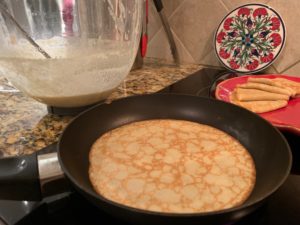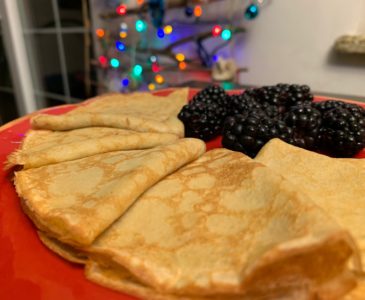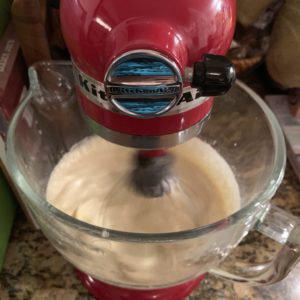These crepes (or “bliny” how I grew up calling them) are the best I have ever tried. I found the original recipe on a blog Prepare & Nourish and modified it a little bit to my needs. The great thing about this recipe is that if you are sensitive to gluten it is gluten free. Most of the gluten free recipes taste different from the original gluten version. Well these crepes seriously taste amazing! Not only they are gluten free, they are also grain free in case you do not eat grains at all. As a side note, I do not recommend to eliminate grains from the diet because whole grains contain variety of complex polysaccharides that are not present in veggies. And these polysaccharides are good for our intestinal microbes. To get the most benefits from the grains it is better to use them unprocessed but this is another topic for another time.
A number of people right now are allergic, intolerant or sensitive to gluten. There can be different reasons for it. I tried to explain these differences and explained how gut microbiota may contribute to gluten sensitivity in this article about two years ago. And now Ubiome (a company that can test your microbiome) has actually included gluten sensitivity in their report. Read more about how to test your microbiome here. If you are missing Lactobacilli and Bifidobacteria you most likely are sensitive to gluten.
When my very good friend Yana Etemadi has introduced me to cassava flour I started experimenting with it. So far I have made cupcakes, ricotta cheese pancakes, kefir pancakes and crepes. The recipes will be slowly coming up on my blog.
What is so special about cassava flour? It is not a grain, it is a grounded root of yuca plant (Manihot esculenta in Latin). So basically it is minimally processed vegetable. Resistant starch is a type of starch that our body cannot convert into sugar as it does for example with potato starch or other starch regularly found in corn and wheat. It is by definition is resistant to digestions. Cassava flour has been shown to increase bacterial biomass in the feces due to the presence of resistant starch in it. Cassava flour contains about 20% of resistant starch and about 70% of regular starch. This amount is enough to feed gut bacteria and makes it suitable to use it as a wheat flour substitute. This article describes the physiochemical properties of cassava flour in relation to other types of flours in great detail.
There are numerous benefits of using resistant starch on the daily basis. They help to:
- improve microbiome composition
- reduce body fat
- improve insuline resistance/sensitivity
To make it even healthier you can add more prebiotic powder to it. I recommend to use prebiotic fiber from Hyperbiotics because it contains three different types of prebiotic fibers (use code MYGUTMATTERS at check-out to get 20% OFF or use this affiliated link). Remember that we need to to consume at least 30 grams or more of fiber a day.
I modified this recipe from the original by replacing butter with ghee. Anything with butter or ghee is more delicious in my opinion. The method of making ghee or clarified butter allows to get rid of the dairy protein casein which makes less allergic. Most people with sensitivity to dairy can consume ghee. If you are allergic or hypersensitive to dairy you can substitute it with any oil of your choice.
Pan
I love using my 8 inch cast iron pan for making crepes. Not only it is not stick when used correctly but also safe! great combination.
Stand Mixer
I absolutely love using my Kitchen Aid Stand Mixer. The reason I love it that it is more powerful than hand mixer and while it is mixing I can actually do other things. It helps me to multitask.
Oils Spritzer
I recently discovered this spritzer for myself and I absolutely love it. It is great when you want to add just a little oil but evenly on your pan. You can also use it for salads and many other things.
Ingredients:
- 3 eggs (preferably room temperature)
- 2 cups of plant based milk (I like the milk from Forager project)
- 3/4 cups of gluten free cassava flour (Ottos is the only cassava brand I use)
- 4 tablespoons of melted oil or clarifies butter (I make my own clarified butter but you can purchase this one)
- 2 tablespoons of Prebiotics Fiber of you choice. (My pick is fiber from Hyperbiotics: use code MYGUTMATTERS at check-out to get 20% OFF or use this affiliated link)
- 1 teaspoon of honey (local honey is the best otherwise this one can be an option)
- 1/2 teaspoon of salt (this is my favorite salt for pancakes, breads etc.)
Instructions:
STEP 1
Beat eggs on medium-high until pale yellow and fluffy (approx. 5 minutes).
STEP 2
Add butter, honey, unrefined salt, and cassava flour and beat on low speed to combine.
STEP 3
Add milk, one cup at a time, blending well after each addition.
STEP 4
You can strain the batter through a sieve to remove clumps of flour, but I skipped this step to save time. And it turned out great because my Kitchen Aid stand mixer is doing a great job.
STEP 5
Heat a lightly oiled with spritzer pan over medium heat.
STEP 6
Pour 1/4 cup of the batter onto the pan and tilt it with a circular motion so that the batter coats the surface evenly.


STEP 7
Cook the crêpe for about 20-30 seconds on each side.
STEP 8
Use spatula to help turn it to another side. Loosened with a thin silicon spatula.
STEP 9
Enjoy!

Disclaimer: I only recommend products and services I genuinely love and believe are healthy. I may receive commissions from purchases made through special inks in this article as the majority of the links in mygutmatters.com are affiliated links.






Wany more on recipe
Can I use inulin powder as a prebiotics fiber?
Hi Olga! You, surely, can! Inulin is great in pancakes. It will also add some sweetness to it.